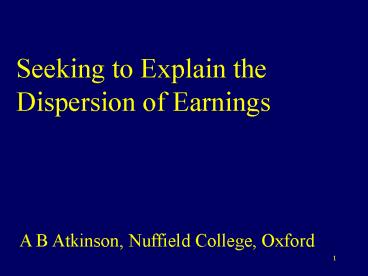Seeking to Explain the Dispersion of Earnings - PowerPoint PPT Presentation
1 / 26
Title:
Seeking to Explain the Dispersion of Earnings
Description:
'Earnings inequalities are one of the most tangible subjects, and ... infinite means pure compensating differential. Relative earnings. g/ e rT. erT. 9 ... – PowerPoint PPT presentation
Number of Views:92
Avg rating:3.0/5.0
Title: Seeking to Explain the Dispersion of Earnings
1
Seeking to Explain the Dispersion of Earnings
A B Atkinson, Nuffield College, Oxford
2
Earnings inequalities are one of the most
tangible subjects, and obviously one of the most
sensitive for European populations, with real
implications for each and every individual
(European Commission, Employment in Europe 2005,
page 164).
3
Earnings Differences among People
- Introduction
- 1. Taking the Supply and Demand Story Seriously
- Modelling the pursuit race between technology and
education - From the skill premium to the distribution of
earnings among people - 2. Empirical Evidence about Earnings Dispersion
- An augmented dataset on earnings for 20 OECD
countries - Patterns of change in the 1980s and 1990-2000
- Conclusions
4
Increasing decile ratio in the US 1979-
5
There is general agreement that the main factor
behind the increase in the relative wage of
skilled versus unskilled workers is a steady
increase in the relative demand for skilled
workers. (Blanchard, Macroeconomics, page 524).
Globalisation fall in relative price of goods in
which unskilled workers are more intensively
engaged. Technical progress biased in favour of
skilled workers.
6
Relative wage of skilled workers ws / wu
?
?
?
Shift in Demand
Relative demand for skilled workers Ls/Lu
Need to model dynamics
7
Simple temporary equilibrium model
- At any point in time, supply is fixed and
relative wage ? clears the market - D? S
- Over time, demand shifts at exogenous rate g
- dlnD/dt g s dln?/dt (1)
- Supply adjusts according to premium over cost of
acquiring skills - dlnS/dt ß ? - e rT (2)
- Hence
- dln?/dt (ß/s) g/ß e rT - ?
8
- dln?/dt (ß/s) g/ß e rT - ?
- ß zero means pure rent, differential grows
without limit - ß positive means convergence
- ß infinite means pure compensating differential
Relative earnings
g/ß e rT
erT
9
Relative wage of skilled workers ws / wu
?
?
g/ß
erT
Relative demand for skilled workers Ls/Lu
10
Lorenz Curve
Ratio of skilled to unskilled in labour force f
Share of total earnings
Skilled
Unskilled
P10
P 90
Share of total population
11
Distributional predictions of continuous demand
shift model
- Wage premium may converge to steady state
- Decile ratio governed by skill premium
- Bottom decile falls as mean (median) even where
premium converges - Top decile may rise or fall as mean (median)
depending on balance of change in wage premium
and in skilled/unskilled employment ratio,
definitely falls if wage premium converges.
12
- Introduction
- 1. Taking the Supply and Demand Story Seriously
- Modelling the pursuit race between technology and
education - From the skill premium to the distribution of
earnings among people - 2. Empirical Evidence about Earnings Dispersion
- An augmented dataset on earnings for 20 OECD
countries - Patterns of change in the 1980s and 1990-2000
- Conclusions
13
2. Empirical Evidence about Earnings Dispersion
OECD View
- Gross earnings inequality has increased on
average in OECD countries for which data are
available. This occurred in countries where
labour market performance improved considerably
(Australia, the Netherlands), as well as in
countries where it deteriorated (Germany,
Hungary, Korea and Poland). Broadly unchanged
wage dispersion was recorded in France, Japan,
Switzerland and UK. - Assessing the Jobs Strategy May 2005
14
OECD comparison of 2000 and 1994
Decile ratio
15
- Short time period
- Series are not necessarily consistent over time
- Looks at decile ratio, not bottom and top deciles
separately - No clear metric what constitutes a rise
16
(No Transcript)
17
- An Augmented Database
- 20 OECD countries
- Identifies breaks in series
- Multiple sources for most countries
- Data back to 1950 where possible
18
An augmented database 20 OECD countries
19
(No Transcript)
20
Metric
- 1979/1980/1981
- versus
- 1989/1990/1991
- versus
- 1999/2000/2001
Two percent criterion P10 50 P90 150 DR 3.00
P10 49 P90 153 DR 3.12
21
Change in Decile Ratio in 1980s (1980 100)
22
(No Transcript)
23
Fall in Bottom Decile as percentage
24
Rise in Top Decile as percentage
25
Earnings deciles in the UK (1977 100)
26
Summary of empirical evidence
- Widening of earnings dispersion in majority of
OECD countries (13 out of 20) - Few (4 out of 20) saw widening in both 1980s and
1990s - There are surprises Germany and Portugal (2 of
the 4) - Changes in decile ratio due more to top (19 out
of 20) than bottom (10 out of 20, of which 3
transition countries) - In UK and US, decile ratio broadly stable since
1990 because rise in bottom decile offsets rise
in top decile - Shift in demand away from unskilled workers
cannot be whole story - Need alternative explanations,
- In particular, to explain upper part of earnings
distribution.































